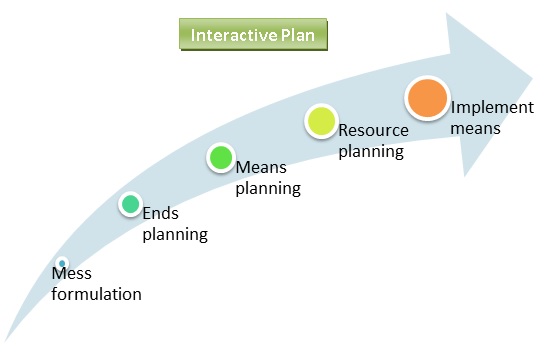- Business Concepts ›
- Human Resources (HR) ›
- Interactive Plan
Interactive Plan
Definition, Importance, Process & Example
This article covers meaning & overview of Interactive Plan from HRM perspective.
What is meant by Interactive Plan?
Interactive plan, also commonly known as participative planning, is a methodology used in project management which involves engaging all the stakeholders and subject matter experts to develop a successful and reliable project. Interactive planning methodology was formulated to solve an interconnected set of problems by R.L. Ackoff, a pioneer researcher in the field of management science and systems thinking.
Importance of Interactive Plan
As per interactive plans, the planning is even more important than or at least as important as the plan itself. It aims at creating a fruitful future by concentrating, planning and working in the present. Any project, regardless of its duration, characteristics, size, type, and duration consists of activities which are interconnected to one another. The level of complexity is so high that any activity in one department not just impacts this department but other departments as well.
Thus, a system which can synchronize all these departments will definitely improve the functionality of the overall system and “Interactive plans” does this job.

Interactive Plan Process
The methodology consists of five phases:
1. Mess formulation: It consists of a description of the problems to be addressed and various possible opportunities available to the company.
2. Ends planning: This phase includes identifying the gaps present in the existing plan
3. Means planning: This phase includes thinking upon and designing the alternate ways to address the gaps identified during the Ends planning phase.
4. Resource planning: This phase includes determining the available resources, the resources needed to address the problems and the plan to address the resource gap.
5. Implement means: This phase requires selecting the best and the most viable alternatives out of the available options, allocating the tasks to the concerned people and developing a control mechanism to check on the progress.
Principles of Interactive Plan
Interactive Plans consists of 4 main principles:
1. Participative Principle: This implies participation is a must to arrive at an effective plan.
2. Integrated Principle: This implies that each level of planning necessarily needs to be integrated with every other level.
3. Continuity Principle: This focuses on the importance of continuous and regular modification and review of the plan.
4. Coordinated Principle: This emphasizes on interdependent and simultaneous planning across all the parts of the system.
Interactive plans enable the stakeholders to know the organization much deeply and broadly. They also get to understand their roles better in achieving the company’s objectives.
Also, Interactive plans enable addressing various planning problems such as resource overloads, order delays, and shortages. Also, interactive plans enable sequencing on resources and designing the campaign definition.
Advantages of Interactive Plan
1. Interactive plans help in identifying critical constraints, assumptions, milestones and enables developing vital conduct of communication. It also enhances the knowledge and the scope of the project among the stakeholders.
2. It promotes the participation of all the stakeholders which, in turn, increases the possibility of having the best solution possible.
3. Interactive plans are largely flexible and are applicable to a variety of applications and purposes such as risk mitigation, project post-mortems, goal setting or any other aspect involved in project management.
Disadvantages of Interactive Plan
1. Despite the numerous benefits the interactive plans have to offer, not every organization is able to implement it as implementing it requires excellent communication skills, people skills and a high degree of analytical skills.
2. To implement Interactive plans effectively, the energy level is needed to be maintained high and an atmosphere needs to be created where different stakeholders are willing to share their ideas. Not doing so scraps the whole idea and motive of the interactive plans.
Example of Interactive Plan
For example, a company A plans to launch a new smartphone next year. The normal approach of it is let the R&D department do the research work, marketing department frame marketing strategies, design team to work on this smartphone’s design and other departments all work independently. On the other hand, implementing interactive plans by this company will enable all these departments to sit at a table and work towards this product coherently rather than independently. It will enable all the departments to understand each other’s positions well and will bring them on the same page towards working on this new product.
Hence, this concludes the definition of Interactive Plan along with its overview.
This article has been researched & authored by the Business Concepts Team which comprises of MBA students, management professionals, and industry experts. It has been reviewed & published by the MBA Skool Team. The content on MBA Skool has been created for educational & academic purpose only.
Browse the definition and meaning of more similar terms. The Management Dictionary covers over 1800 business concepts from 5 categories.
Continue Reading:
What is MBA Skool?About Us
MBA Skool is a Knowledge Resource for Management Students, Aspirants & Professionals.
Business Courses
Quizzes & Skills
Quizzes test your expertise in business and Skill tests evaluate your management traits
Related Content
All Business Sections
Write for Us